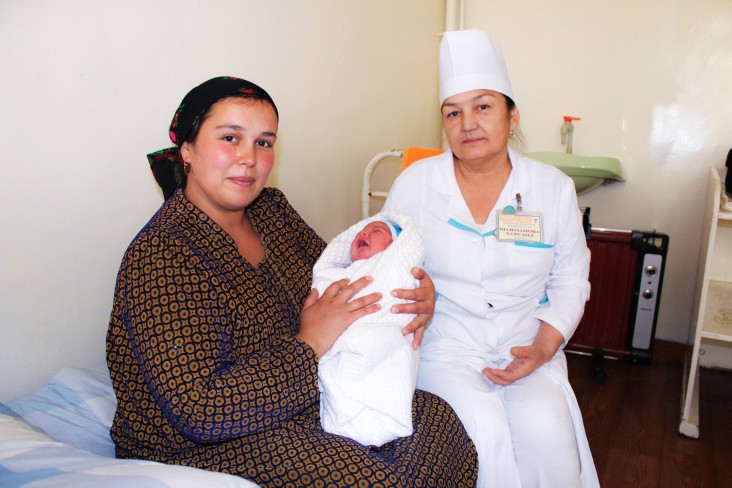Speeches Shim

March 2018—Although Tajikistan has made progress in reducing maternal deaths over the last decade, it still has a high maternal mortality rate with 32 maternal deaths for every 100,000 live births. However, attitudes toward home births—often a risky situation for women in labor—are changing.
“I delivered my oldest daughter at home,” says Gulrukhsor Talbieva, a 26-year-old mother of five, who lives in Tajikistan’s remote Bokhtar district. She also delivered her second baby at home and developed a terrible headache that lasted for days. She didn’t know it at the time, but she had eclampsia, a life-threatening condition. “I thought that it is only natural to deliver at home,” she says.
In 2014, Talbieva gave birth to her third child at home and, as there was no trained health worker to manage bleeding, she developed postpartum hemorrhage. Talbieva’s husband took her to the Bokhtar District Hospital, but she was transferred to the regional hospital for emergency obstetric care.
Talbieva delivered her fourth child in the district hospital’s maternity ward, but it was so cold and uncomfortable, especially for nursing a new baby, she decided to deliver her next child at home.
USAID, through its Feed the Future Tajikistan Health and Nutrition Activity, partners with hospitals, primary health care centers, and communities to address preventable causes of maternal deaths: delays in seeking maternity care or reaching a health facility, and lack of high-quality care once at a facility. The activity focuses on 12 districts in southwestern Tajikistan, including Bokhtar.
In 2016, the project conducted in-depth assessments of 14 hospitals and found that many were understaffed, underequipped and short on medical supplies. They also suffered from poor-quality control and managerial oversight and even lacked running water.
Feed the Future worked with the Bokhtar District Hospital to train its midwives, obstetrician-gynecologists, and other staff in effective perinatal care—including how to manage complications—and provided supportive supervision for health workers and mentoring for facility managers. The activity also upgraded the hospital’s maternity ward with new equipment and supplies, and worked with hospital managers to improve the quality of care.
In addition, 1,400 volunteers were trained and mobilized to teach women in their neighborhoods about proper prenatal care and when to go to the health facility.
One of these community health educators is Talbieva's neighbor, who explained to the couple the risks of home births, and that the renovated district hospital and trained staff were now ready to help women deliver their babies safely.
Talbieva gave birth to her fifth child in November 2017 at Bokhtar District Hospital, which was fully renovated and equipped, clean and warm with running water. And, with the recent training of medical staff, Talbieva had a safe labor and delivery.
“It really is better to deliver at the hospital. Doctors, midwives and the other health care staff take care of women and newborn babies every minute, checking blood pressure, helping when there is rupture of the uterus, or during bleeding. I have started to ask myself: Why would I deliver children at home?” says Talbieva.
Today, thanks to the project, all nine maternal hospitals where the project provides active support have seen significant improvements. Bokhtar District Hospital leads in statistical evidence: The number of home births in the district decreased from 6.3 percent to 3.2 percent, and postpartum hemorrhage decreased from 1.3 percent to 0.8 percent. In other pilot maternity hospitals, improvement increased between 15 percent and 70 percent across 131 indicators.
USAID’s Feed the Future Tajikistan Health and Nutrition Activity, which runs from October 2015 to September 2020, is designed to improve the health and nutrition of mothers and children under 5 in southwestern Tajikistan.
LINKS
Follow @FeedtheFuture, @USAIDCtrAsia, on Facebook, on Flickr, on YouTube

Comment
Make a general inquiry or suggest an improvement.